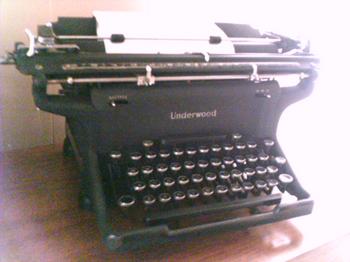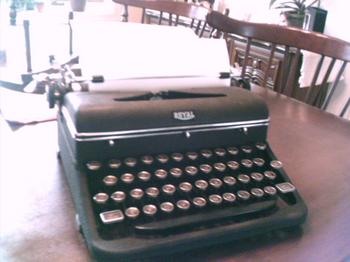I have a hobby I recently picked up after watching a biopic on David McCullough, author of best selling books such as John Adams and 1776. In this piece I saw on television Mr. McCullough was typing on a 60 year old Royal Standard typewriter. I found it interesting in this day and age that such a prolific writer such as McCullough would still use a machine that by all accounts time has passed by.
 | I then became interested in the old bangers. They were beautiful and somewhat romantic. It reminds me of a time in fedora hat wearing detectives searching for a priceless gem colored bird. Then my wife gave me an Underwood #5 from about 1946. It works well, and after a quick cleaning, it looks nearly new. |
This past weekend I picked up 3 more typewriters. A Smith Corona quiet portable from about 1950 or so in somewhat poor shape. Luckily it was a freebie. I got a 1940s Royal Quiet Deluxe for $60. After a quick cleaning and turning of the ribbon, I was typing "Now is the time for all good men to come to the aid of their country", like any good typing student. The other one that I got was the crown jewel of my collection so far. For $10, I am getting a mint Royal Portable Touch Control, circa 1936. This one came with everything original, including box, instructions, carrying case and dust cover. Call me strange. My wife has already threatened to divorce me due to this strange hobby. And it is something strange. But everyone collects things that appeal to him or her. My wife collects Mary Moo Moos; and though I think they are pretty, they aren't my cup of tea. A commenter at Design Observer said it well, that the people who seem most enthralled with these throwbacks to the era of Hemmingway and Kerouac are people like me and younger who really haven't had the experience of typing "unplugged". Sure, my first typing experiences in middle school were on a typewriter, but an electric typewriter with memory and spell check hardly compares to an old Underwood. And that was before I could touch-type and had to rely on the hunt and peck method. I was taught to type the "proper" way in high school on the school's brand new IBM 386s. Before windows and clickable interface, these machines were basically typewriters that had TV screens. Nothing compared to what we are all familiar with now. | 
|
There is something esthetically pleasing about banging the keys on an old manual typewriter, even if it is just for fun. You press the letter, a hinge swings the plate forward, it makes contact with the ribbon and paper, and you have a letter. You are actually creating the words from your own fingers, through might of muscle, instead of creating an electric response inside the transistors of a machine. This is more akin to sculpting, and is probably why so many professional writers and wanna-be professional writers still use manuals today.
So, as I prepare to write the all American Novel, or at least just practice typing, I add to my collection of these large items. Whole shelves in my office will now be adorned with these antique implements of writing. There to remind me of times gone when people didn't have auto spell checkers or cut and paste, and if I'm luckily they will be my muse, and help me channel Hemmingway through my Royals or Kerouac through my Underwood.